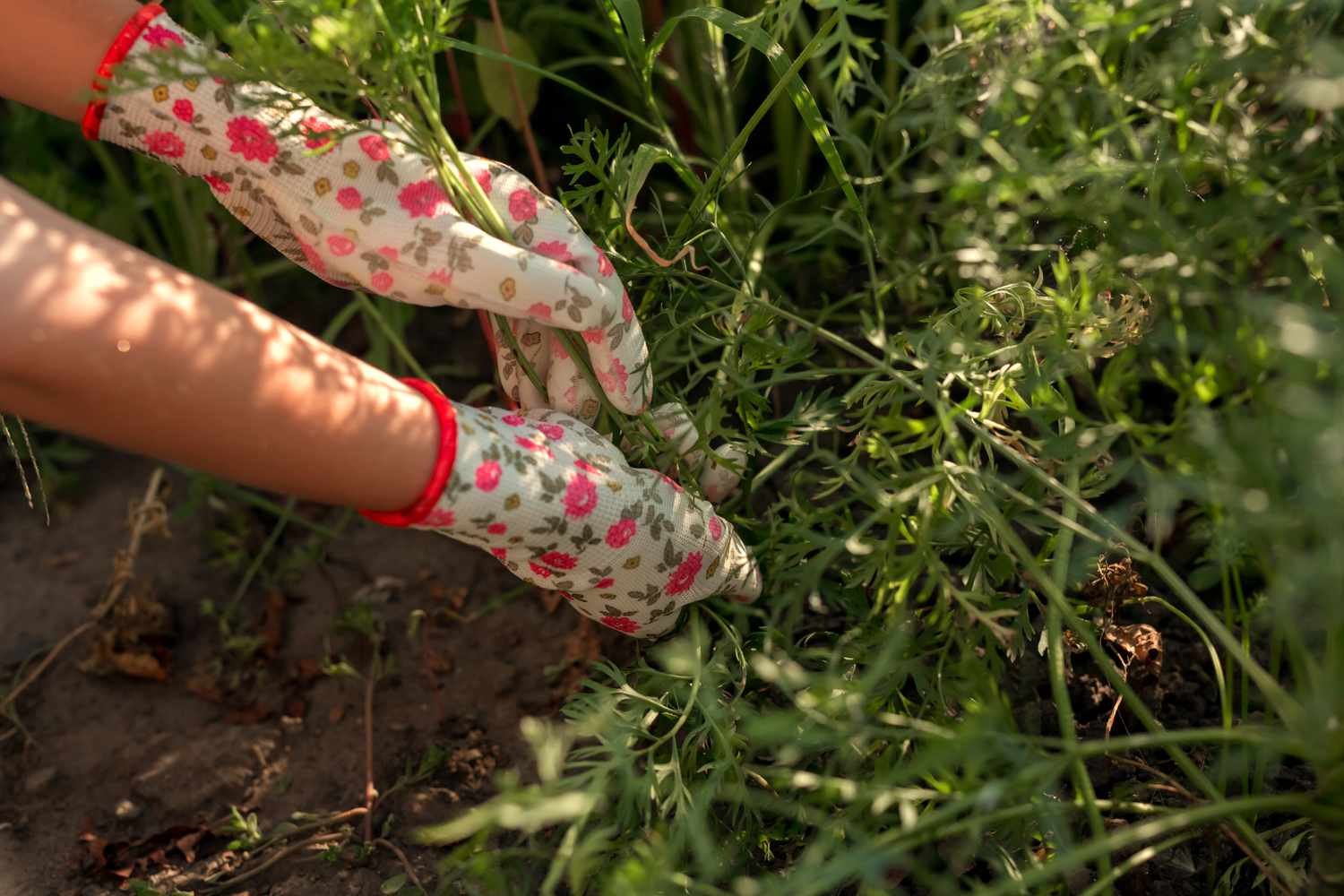Before the sunny days of summer come to an end, there are still many gardening tasks to tackle before the fall season. While planting an autumn garden may be on your to-do list, there are other chores you need to accomplish to ensure you have flourishing flowers and plants for the spring season, too.
We went straight to the experts to take the guesswork out of the gardening deeds that need to be done and find out which tasks you should prioritize before the chill of fall sets in.
Weed and Clean Out Garden Beds
Nathan Heinrich, a horticulturist and botanical designer, says you should start your checklist by walking through your garden with a pair of clippers and a bucket. You want to find the plants that are finished producing, including crops and flowers that are past their peak, and cut them back or pull them out.
“I compost most of my spent annuals, but I throw out anything with signs of disease or pests,” Heinrich says. “This helps prevent problems from carrying over to next year. Don’t assume winter will kill everything. Some pests overwinter in debris, especially in northern gardens.”
Collect and Save Seeds
Heinrich says, before you toss anything, you should look for plants that grew well this season. “Did a certain tomato plant thrive? Did your lettuce bolt later than others?” he says. “I save seeds from the healthiest, most productive plants. It’s one of the easiest ways to improve your garden over time.”
“Let seed heads dry fully before storing them,” he continues. “Keep them in paper envelopes, labeled with the variety and date. Then store them somewhere cool and dry.”
Divide Perennials and Transplant Them
Jane Dobbs, an expert gardener and gardening team lead at Allan’s Gardeners, says that fall is an ideal time to divide and replant crowded perennials such as daylilies, hostas, and irises. She advises watering the transplants well to help them establish roots before the harsh weather of winter sets in.
Heinrich advises dividing perennials at least four weeks before the first freeze for those that live in colder zones because it will give roots time to settle in.
Prune Perennials, Trees, and Shrubs
Pruning certain perennials, trees, and shrubs should be done before the fall season sets in. Heinrich states that late summer is a good time to trim back many perennials, but not all types. “I prune my peonies, irises, and daylilies now,” he says. “I leave echinacea, rudbeckia, and sedum standing—both for winter interest and to feed birds.”
Dobbs says trees and shrubs should also be pruned to remove dead or damaged branches. “Lightly prune deciduous shrubs to encourage strong spring growth,” she says. “Make sure you don’t prune too hard on spring-flowering shrubs, because you’ll lose next year’s buds.”
Start a Fall Compost Pile
Another important task that will benefit next year’s garden is starting a compost pile. Heinrich states that he starts a new compost pile every year in late summer. “There’s plenty of green waste from clearing out the garden, and dry leaves are just around the corner,” he says. “Mix green materials like garden trimmings and grass clippings with brown materials like shredded leaves or straw.”
If you don’t have enough brown materials yet, he suggests stockpiling leaves in a dry bin for later use. He highly recommends getting this task started because a dedicated fall compost pile can give you rich material for early spring use.
Plant Fall Crops
The great news for garden lovers is that you still have the fall season to plant various crops. Heinrich says if you live in a Mediterranean or mild zone, there’s still time to grow. “I plant lettuce, spinach, arugula, and radishes in August and early September,” he says. “Even in cold zones, you can squeeze in a few fast-growing greens.”
There are still plenty of vegetables you can plant, so you have fresh produce to enjoy during the fall season. He recommends covering crops with a row of fabric as nights cool down.
Plant Spring Bulbs
The best thing about spring is seeing beautiful blooms burst to life from your favorite flowers. Heinrich says fall is the time to plant bulbs for spring color. He suggests planting daffodils, crocus, and tulips when the nights are cool, but the ground hasn’t frozen yet.
However, he warns not to wait too long because the bulbs need time to root before winter. If you live in a cold zone, you should aim to plant your spring bulbs at least four to six weeks before the first hard frost.
Mulch Around Trees and Shrubs
Heinrich says that trees and shrubs benefit from mulch before winter. You should spread a layer of bark mulch or shredded leaves 2–3 inches thick around the base of my trees and large shrubs. Be sure to keep mulch a few inches away from the trunk to prevent rot.
“If you’re in a cold zone, mulch helps insulate roots and reduce freeze-thaw cycles that can cause root damage,” Heinrich says. “In Mediterranean areas, it helps conserve moisture going into the dry season.”
Dobbs recommends applying mulch over beds to protect roots and suppress weeds. “If necessary, cover tender perennials with mulch or frost covers,” she suggests.
Bring Tender Plants Indoors Before the First Frost
Before the first frost takes you by surprise, you want to make sure you bring in tender plants to keep them alive. “If you grow citrus, succulents, or tropicals, now’s the time to bring them inside,” Heinrich says. “I rinse the leaves, check for insects, and repot anything that needs it.”
A sunroom or greenhouse is the best option in severe fall and winter regions. You can utilize grow lights to help provide your plants with additional light needed while they are indoors.
Protect Young or Vulnerable Plants
You also need to protect plants that are in the ground to prevent them from being damaged by the bitter frost. “If you’ve planted anything new this year—especially trees or shrubs—it may need extra protection to survive winter,” Heinrich says. “In northern climates, I sometimes use burlap screens to protect evergreen shrubs from frost and windburn.”
Prepare and Fertilize Your Yard
Dobbs says that fall is a good time to fertilize cool-season lawns, as it will help their roots grow deep and strong. “Scarify your lawn to remove thatch, aerate compacted areas, and apply an autumn lawn feed,” she says. “Overseed patchy sections to improve density and ensure a lush lawn in spring.”
Make a Plan for Spring
Last but not least, Heinrich advises starting to plan for spring. “Before you forget what worked and what didn’t, write it down,” he says. “What do you want to grow more of? What should you change? I keep a simple garden notebook. Each fall, I jot down what I planted, when I planted it, and how it performed. I also sketch out rough plans for the next season.”
“Fall comes fast,” he continues. “In colder zones, it can feel like you blink and the first frost is here. The more you do now, the easier your winter rest—and the stronger your spring starts. These tasks don’t take long if you spread them out over a few weeks. Walk through your garden, make a list, and tackle one thing at a time.”






